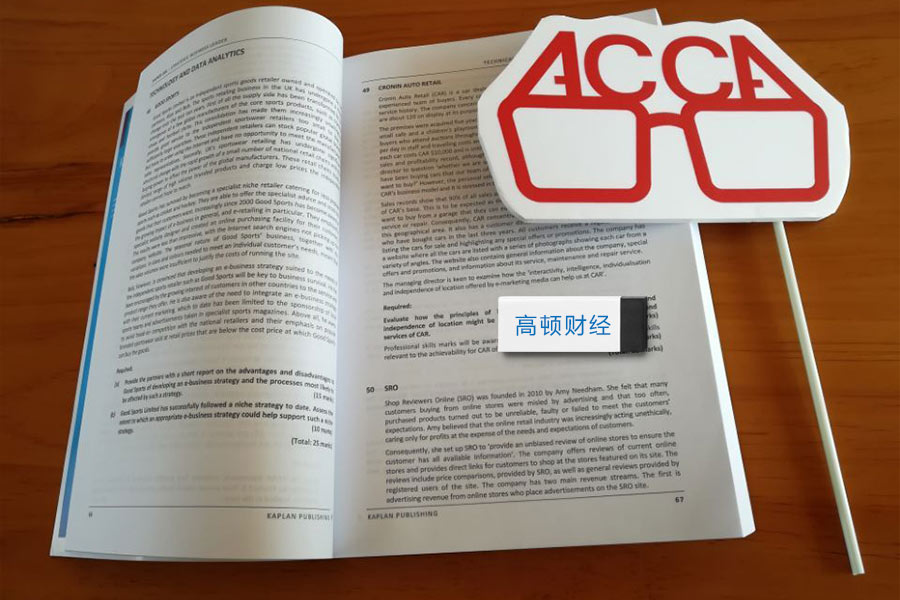2015年ACCA P4 高级财务管理考试大纲
来源:
高顿网校
2015-03-25
? ACCA 2014 All rights reserved.
1
Advanced Financial
Management (P4)
December 2014 & June
2015
This syllabus and study guide is designed to help
with planning study and to provide detailed
information on what could be assessed in
any examination session.
THE STRUCTURE OF THE SYLLABUS AND
STUDY GUIDE
Relational diagram of paper with other papers
This diagram shows direct and indirect links
between this paper and other papers preceding or
following it. Some papers are directly underpinned
by other papers such as Advanced Performance
Management by Performance Management. These
links are shown as solid line arrows. Other papers
only have indirect relationships with each other
such as links existing between the accounting and
auditing papers. The links between these are shown
as dotted line arrows. This diagram indicates where
you are expected to have underpinning knowledge
and where it would be useful to review previous
learning before undertaking study.
Overall aim of the syllabus
This explains briefly the overall objective of the
paper and indicates in the broadest sense the
capabilities to be developed within the paper.
Main capabilities
This paper’s aim is broken down into several main
capabilities which divide the syllabus and study
guide into discrete sections.
Relational diagram of the main capabilities
This diagram illustrates the flows and links between
the main capabilities (sections) of the syllabus and
should be used as an aid to planning teaching and
learning in a structured way.
Syllabus rationale
This is a narrative explaining how the syllabus is
structured and how the main capabilities are linked.
The rationale also explains in further detail what the
examination intends to assess and why.
Detailed syllabus
This shows the breakdown of the main capabilities
(sections) of the syllabus into subject areas. This is
the blueprint for the detailed study guide.
Approach to examining the syllabus
This section briefly explains the structure of the
examination and how it is assessed.
Study Guide
This is the main document that students, learning
and content providers should use as the basis of
their studies, instruction and materials.
Examinations will be based on the detail of the
study guide which comprehensively identifies what
could be assessed in any examination session.
The study guide is a precise reflection and
breakdown of the syllabus. It is divided into sections
based on the main capabilities identified in the
syllabus. These sections are divided into subject
areas which relate to the sub-capabilities included
in the detailed syllabus. Subject areas are broken
down into sub-headings which describe the detailed
outcomes that could be assessed in examinations.
These outcomes are described using verbs
indicating what exams may require students to
demonstrate, and the broad intellectual level at
which these may need to be demonstrated
(*see intellectual levels below)。
INTELLECTUAL LEVELS
The syllabus is designed to progressively broaden
and deepen the knowledge, skills and professional
values demonstrated by the student on their way
through the qualification.
The specific capabilities within the detailed
syllabuses and study guides are assessed at one of
three intellectual or cognitive levels:
LevelⅠ: Knowledge and comprehension
? ACCA 2014 All rights reserved.
2
LevelⅡ: Application and analysis
LevelⅢ: Synthesis and evaluation
Very broadly, these intellectual levels relate to the
three cognitive levels at which the Knowledge
module, the Skills module and the Professional level
are assessed.
Each subject area in the detailed study guide
included in this document is given a 1, 2, or
3 superscript, denoting intellectual level, marked at
the end of each relevant line. This gives an
indication of the intellectual depth at which an area
could be assessed within the examination. However,
while level 1 broadly equates with the Knowledge
module, level 2 equates to the Skills module and
level 3 to the Professional level, some lower level
skills can continue to be assessed as the student
progresses through each module and level. This
reflects that at each stage of study there will be a
requirement to broaden, as well as deepen
capabilities. It is also possible that occasionally
some higher level capabilities may be assessed at
lower levels.
LEARNING HOURS AND EDUCATION
RECOGNITION
The ACCA qualification does not prescribe or
recommend any particular number of learning hours
for examinations because study and learning
patterns and styles vary greatly between people and
organisations. This also recognises the wide
diversity of personal, professional and educational
circumstances in which ACCA students find
themselves.
As a member of the International Federation of
Accountants, ACCA seeks to enhance the education
recognition of its qualification on both national and
international education frameworks, and with
educational authorities and partners globally. In
doing so, ACCA aims to ensure that its qualifications
are recognized and valued by governments,
regulatory authorities and employers across all
sectors. To this end, ACCA qualifications are
currently recognized on the education frameworks in
several countries. Please refer to your national
education framework regulator for further
information.
Each syllabus contains between 23 and 35 main
subject area headings depending on the nature of
the subject and how these areas have been broken
down.
GUIDE TO EXAM STRUCTURE
The structure of examinations varies within and
between modules and levels.
The Fundamentals level examinations contain
100% compulsory questions to encourage
candidates to study across the breadth of each
syllabus.
The Knowledge module is assessed by equivalent
two-hour paper based and computer based
examinations.
The Skills module examinations F5-F9 are all paper
based three-hour papers containing a mix of
objective and longer type questions. The Corporate
and Business Law (F4) paper is a two- hour
computer based objective test examination which is
also available as a paper based version from the
December 2014 examination session.
The Professional level papers are all three-hour
paper based examinations, all containing two
sections. Section A is compulsory, but there will be
some choice offered in Section B.
For all three hour examination papers, ACCA has
introduced 15 minutes reading and planning time.
This additional time is allowed at the beginning of
each three-hour examination to allow candidates to
read the questions and to begin planning their
answers before they start writing in their answer
books. This time should be used to ensure that all
the information and exam requirements are properly
read and understood.
During reading and planning time candidates may
only annotate their question paper. They may not
write anything in their answer booklets until told to
do so by the invigilator.
The Essentials module papers all have a Section A
containing a major case study question with all
requirements totalling 50 marks relating to this
case. Section B gives students a choice of two from
three 25 mark questions.
? ACCA 2014 All rights reserved.
3
Section A of both the P4 and P5 Options papers
contain one 50 mark compulsory question, and
Section B will offer a choice of two from three
questions each worth 25 marks each.
Section A of each of the P6 and P7 Options papers
contains 60 compulsory marks from two questions;
question 1 attracting 35 marks, and question 2
attracting 25 marks. Section B of both these
Options papers will offer a choice of two from three
questions, with each question attracting 20 marks.
All Professional level exams contain four
professional marks.
The pass mark for all ACCA Qualification
examination papers is 50%.
GUIDE TO EXAMINATION ASSESSMENT
ACCA reserves the right to examine anything
contained within the study guide at any examination
session. This includes knowledge, techniques,
principles, theories, and concepts as specified.
For the financial accounting, audit and assurance,
law and tax papers except where indicated
otherwise, ACCA will publish examinable
documents once a year to indicate exactly
what regulations and legislation could potentially be
assessed within identified examination sessions
For paper based examinations regulation issued or
legislation passed on or before 31st August annually,
will be examinable from 1st September of the
following year to 31st August t of the year after that.
Please refer to the examinable documents for the
paper (where relevant) for further information.
Regulation issued or legislation passed in
accordance with the above dates may be
examinable even if the effective date is in the future.
The term issued or passed relates to when
regulation or legislation has been formally approved.
The term effective relates to when regulation or
legislation must be applied to an entity transactions
and business practices.
The study guide offers more detailed guidance on
the depth and level at which the examinable
documents will be examined. The study guide
should therefore be read in conjunction with the
examinable documents list.
? ACCA 2014 All rights reserved.
4
Syllabus
AIM
To apply relevant knowledge, skills and exercise
professional judgement as expected of a senior
financial executive or advisor, in taking or
recommending decisions relating to the financial
management of an organisation in private and
public sectors.
MAIN CAPABILITIES
On successful completion of this paper, candidates
should be able to:
A Explain and evaluate the role and responsibility
of the senior financial executive or advisor in
meeting conflicting needs of stakeholders
B Evaluate the impact of macro economics and
recognise the role of international financial
institutions in the financial management of
multinationals
C Evaluate potential investment decisions and
assessing their financial and strategic
consequences, both domestically and
internationally
D Assess and plan acquisitions and mergers as
an alternative growth strategy
E Evaluate and advise on alternative corporate
re-organisation strategies
F Apply and evaluate alternative advanced
treasury and risk management techniques
G Identify and assess the potential impact of
emerging issues in finance and financial
management.
RELATIONAL DIAGRAM OF MAIN CAPABILITIES
FM (F9)
AFM (P4)
MA (F2)
PA (P1) CR (P2)
Treasury and advanced risk management
techniques (F)
Corporate reconstruction and re-organisation (E)
Role and responsibility towards stakeholders (A)
Advanced investment appraisal (C)
Economic
environment for
multinational
organisations
(B)
Acquisition and mergers (D)
Emerging issues in finance and financial management (G)
? ACCA 2014 All rights reserved.
5
RATIONALE
This syllabus develops upon the core financial
management knowledge and skills covered in the
F9, Financial Management, syllabus at the
Fundamentals level and prepares candidates to
advise management and/or clients on complex
strategic financial management issues facing an
organisation.
The syllabus starts by exploring the role and
responsibility of a senior executive or advisor in
meeting competing needs of stakeholders within the
business environment of multinationals. The
syllabus then re-examines investment and financing
decisions, with the emphasis moving towards the
strategic consequences of making such decisions in
a domestic, as well as international, context.
Candidates are then expected to develop further
advisory skills in planning strategic acquisitions and
mergers and corporate re-organisations.
The next part of the syllabus re-examines, in the
broadest sense, the existence of risks in business
and the sophisticated strategies which are employed
in order to manage such risks. It builds on what
candidates would have covered in the F9, Financial
Management, syllabus and the P1,Governance, Risk
and Ethics, syllabus. The syllabus finishes by
examining the impact of emerging issues in finance.
? ACCA 2014 All rights reserved.
6
DETAILED SYLLABUS
A Role and responsibility towards stakeholders
1. The role and responsibility of senior financial
executive/advisor
2. Financial strategy formulation
3. Conflicting stakeholder interests
4. Ethical issues in financial management
5. Environmental issues and integrated reporting
B Economic environment for multinational
organisations
1. Management of international trade and finance
2. Strategic business and financial planning for
multinational organisations
C Advanced investment appraisal
1. Discounted cash flow techniques
2. Application of option pricing theory in
investment decisions
3. Impact of financing on investment decisions
and adjusted present values
4. Valuation and the use of free cash flows
5. International investment and financing
decisions
D Acquisitions and mergers
1. Acquisitions and mergers versus other growth
strategies
2. Valuation for acquisitions and mergers
3. Regulatory framework and processes
4. Financing acquisitions and mergers
E Corporate reconstruction and re-organisation
1. Financial reconstruction
2. Business re-organisation
F Treasury and advanced risk management
techniques
1. The role of the treasury function in
multinationals
2. The use of financial derivatives to hedge
against forex risk
3. The use of financial derivatives to hedge
against interest rate risk
4. Dividend policy in multinationals and transfer
pricing
G Emerging issues in finance and financial
management
1. Developments in world financial markets
2. Developments in international trade and
finance
3. Developments in Islamic financing
? ACCA 2014 All rights reserved.
7
APPROACH TO EXAMINING THE SYLLABUS
The P4, Advanced Financial Management, paper
builds upon the skills and knowledge examined in
the F9, Financial Management, paper. At this stage
candidates will be expected to demonstrate an
integrated knowledge of the subject and an ability to
relate their technical understanding of the subject to
issues of strategic importance to the organisation.
The study guide specifies the wide range of
contextual understanding that is required to achieve
a satisfactory standard at this level.
Examination Structure
The examination will be a three-hour paper in two
sections:
Section A:
Section A will contain a compulsory question,
comprising of 50 marks.
Section A will normally cover significant issues
relevant to the senior financial manager or advisor
and will be set in the form of a case study or
scenario. The requirements of the section A question
are such that candidates will be expected to show a
comprehensive understanding of issues from across
the syllabus. The question will contain a mix of
computational and discursive elements. Within this
question candidates will be expected to provide
answers in a specified form such as a short report or
board memorandum commensurate with the
professional level of the paper in part or whole of
the question.
Section B:
In section B candidates will be asked to answer two
from three questions, comprising of 25 marks each.
Section B questions are designed to provide a more
focused test of the syllabus. Questions will normally
contain a mix of computational and discursive
elements, but may also be wholly discursive or
evaluative where computations are already
provided.
Total 100 marks
? ACCA 2014 All rights reserved.
8
Study Guide
A ROLE AND RESPONSIBILITY TOWARDS
STAKEHOLDERS
1. The role and responsibility of senior financial
executive/advisor
a) Develop strategies for the achievement of the
organisational goals in line with its agreed
policy framework. [3]
b) Recommend strategies for the management of
the financial resources of the organisation such
that they are utilised in an efficient, effective
and transparent way. [3]
c) Advise the board of directors or management of
the organisation in setting the financial goals of
the business and in its financial policy
development with particular reference to: [2]
i) Investment selection and capital resource
allocation
ii) Minimising the cost of capital
iii) Distribution and retention policy
iv) Communicating financial policy and
corporate goals to internal and external
stakeholders
v) Financial planning and control
vi) The management of risk.
2. Financial strategy formulation
a) Assess organisational performance using
methods such as ratios, trends, EVATM and
MVA.[3]
b) Recommend the optimum capital mix and
structure within a specified business context
and capital asset structure.[3]
c) Recommend appropriate distribution and
retention policy.[3]
d) Explain the theoretical and practical rationale
for the management of risk. [3]
e) Assess the organisation’s exposure to business
and financial risk including operational,
reputational, political, economic, regulatory
and fiscal risk.[3]
f) Develop a framework for risk management,
comparing and contrasting risk mitigation,
hedging and diversification strategies.[3]
g) Establish capital investment monitoring and
risk management systems.[3]
3. Conflicting stakeholder interests
a) Assess the potential sources of the conflict
within a given corporate governance/
stakeholder framework informed by an
understanding of the alternative theories of
managerial behaviour. [3]
Relevant underpinning theory for this
assessment would be:
i) The separation of ownership and control
ii) Transaction cost economics and
comparative governance structures
iii) Agency Theory.
b) Recommend, within specified problem
domains, appropriate strategies for the
resolution of stakeholder conflict and advise on
alternative approaches that may be adopted. [3]
c) Compare the different governance structures
and policies (with particular emphasis upon
the European stakeholder and the US/UK
shareholder model) and with respect to the role
of the financial manager. [3]
4. Ethical issues in financial management
a) Assess the ethical dimension within business
issues and decisions and advise on best
practice in the financial management of the
organisation.[3]
b) Demonstrate an understanding of the
interconnectedness of the ethics of good
business practice between all of the functional
areas of the organisation.[2]
c) Establish an ethical financial policy for the
financial management of the organisation
which is grounded in good governance, the
highest standards of probity and is fully aligned
with the ethical principles of the Association. [3]
d) Recommend an ethical framework for the
development of an organisation’s financial
policies and a system for the assessment of its
? ACCA 2014 All rights reserved.
9
ethical impact upon the financial management
of the organisation.[3]
e) Explore the areas within the ethical framework
of the organisation which may be undermined
by agency effects and/or stakeholder conflicts
and establish strategies for dealing with
them.[3]
5. Environmental issues and integrated reporting
a) Assess the issues which may impact upon
organisational objectives and governance
from:[3]
i) Sustainability and environmental risk
ii) The carbon-trading economy and emissions
iii) The role of the environment agency
iv) Environmental audits and the triple bottom
line approach.
b) Assess and advise on the impact of investment
and financing strategies and decisions on
the organisations' stakeholders, from an
integrated reporting and governance
perspective .[2]
B ECONOMIC ENVIRONMENT FOR
MULTINATIONALS
1. Management of international trade and
finance
a) Advise on the theory and practice of free trade
and the management of barriers to trade.[3]
b) Demonstrate an up to date understanding of
the major trade agreements and common
markets and, on the basis of contemporary
circumstances, advise on their policies and
strategic implications for a given business.[3]
c) Discuss the objectives of the World Trade
Organisation.[2]
d) Discuss the role of international financial
institutions within the context of a globalised
economy, with particular attention to the
International Monetary Fund, the Bank of
International Settlements, The World Bank and
the principal Central Banks (the Fed, Bank of
England, European Central Bank and the Bank
of Japan)。[2]
e) Assess the role of the international financial
markets with respect to the management of
global debt, the financial development of the
emerging economies and the maintenance of
global financial stability.[2]
2. Strategic business and financial planning for
multinationals
a) Advise on the development of a financial
planning framework for a multinational
organisation taking into account:[3]
i) Compliance with national regulatory
requirements (for example the London
Stock Exchange admission requirements)
ii) The mobility of capital across borders and
national limitations on remittances and
transfer pricing
iii) The pattern of economic and other risk
exposures in the different national markets
iv) Agency issues in the central coordination of
overseas operations and the balancing of
local financial autonomy with effective
central control.
C ADVANCED INVESTMENT APPRAISAL
1. Discounted cash flow techniques
a) Evaluate the potential value added to an
organisation arising from a specified capital
investment project or portfolio using the net
present value (NPV) model.[3]
Project modelling should include explicit
treatment and discussion of:
i) Inflation and specific price variation
ii) Taxation including capital allowances and
tax exhaustion
iii) Single period and multi-period capital
rationing. Multi-period capital rationing to
include the formulation of programming
methods and the interpretation of their
output
iv) Probability analysis and sensitivity analysis
when adjusting for risk and uncertainty in
investment appraisal
v) Risk adjusted discount rates.
b) Outline the application of Monte Carlo
simulation to investment appraisal.[2]
Candidates will not be expected to undertake
simulations in an examination context but will
? ACCA 2014 All rights reserved.
10
be expected to demonstrate an understanding
of:
i) Simple model design
ii) The different types of distribution
controlling the key variables within the
simulation
iii) The significance of the simulation output
and the assessment of the likelihood of
project success
iv) The measurement and interpretation of
project value at risk.
c) Establish the potential economic return (using
internal rate of return (IRR) and modified
internal rate of return) and advise on a
project’s return margin. Discuss the relative
merits of NPV and IRR.[3]
2. Application of option pricing theory in
investment decisions
a) Apply the Black-Scholes Option Pricing (BSOP)
model to financial product valuation and to
asset valuation:[3]
i) Determine and discuss, using published
data, the five principal drivers of option
value (value of the underlying, exercise
price, time to expiry, volatility and the riskfree
rate)
ii) Discuss the underlying assumptions,
structure, application and limitations of the
BSOP model.
b) Evaluate embedded real options within a
project, classifying them into one of the real
option archetypes.[3]
c) Assess, calculate and advise on the value of
options to delay, expand, redeploy and
withdraw using the BSOP model.[3]
3. Impact of financing on investment decisions
and adjusted present values
a) Identify and assess the appropriateness of the
range of sources of finance available to an
organisation including equity, debt, hybrids,
lease finance, venture capital, business angel
finance, private equity, asset securitisation and
sale and Islamic finance. Including assessment
on the financial position, financial risk and the
value of an organisation.[3]
b) Calculate the cost of capital of an organisation,
including the cost of equity and cost of debt,
based on the range of equity and debt sources
of finance. Discuss the appropriateness of
using the cost of capital to establish project
and organisational value, and discuss its
relationship to such value.[3]
c) Calculate and evaluate project specific cost of
equity and cost of capital, including their
impact on the overall cost of capital of an
organisation. Demonstrate detailed knowledge
of business and financial risk, the capital asset
pricing model and the relationship between
equity and asset betas.[3]
d) Assess an organisation’s debt exposure to
interest rate changes using the simple
Macaulay duration method. [3]
e) Discuss the benefits and limitations of duration
including the impact of convexity. [3]
f) Assess the organisation’s exposure to credit
risk, including: [3]
i) Explain the role of, and the risk assessment
models used by the principal rating
agencies
ii) Estimate the likely credit spread over risk
free
iii) Estimate the organisation’s current cost of
debt capital using the appropriate term
structure of interest rates and the credit
spread.
g) Assess the impact of financing and capital
structure upon the organisation with respect
to:[3]
i) Modigliani and Miller propositions, before
and after tax
ii) Static trade-off theory
iii) Pecking order propositions
iv) Agency effects.
h) Apply the adjusted present value technique to
the appraisal of investment decisions that
entail significant alterations in the financial
structure of the organisation, including their
fiscal and transactions cost implications.[3]
i) Assess the impact of a significant capital
investment project upon the reported financial
position and performance of the organisation
? ACCA 2014 All rights reserved.
11
taking into account alternative financing
strategies.[3]
4. Valuation and the use of free cash flows
a) Apply asset based, income based and cash
flow based models to value equity. Apply
appropriate models, including term structure of
interest rates, the yield curve and credit
spreads, to value corporate debt.[3]
b) Forecast an organisation’s free cash flow and
its free cash flow to equity (pre and post
capital reinvestment)。[3]
c) Advise on the value of an organisation using its
free cash flow and free cash flow to equity
under alternative horizon and growth
assumptions.[3]
d) Explain the use of the BSOP model to estimate
the value of equity of an organisation and
discuss the implications of the model for a
change in the value of equity.[2]
e) Explain the role of BSOP model in the
assessment of default risk, the value of debt
and its potential recoverability. [2]
5. International investment and financing
decisions
a) Assess the impact upon the value of a project
of alternative exchange rate assumptions.[3]
b) Forecast project or organisation free cash flows
in any specified currency and determine the
project’s net present value or organisation
value under differing exchange rate, fiscal and
transaction cost assumptions.[2]
c) Evaluate the significance of exchange controls
for a given investment decision and strategies
for dealing with restricted remittance.[3]
d) Assess the impact of a project upon an
organisation’s exposure to translation,
transaction and economic risk.[3]
e) Assess and advise on the costs and benefits of
alternative sources of finance available within
the international equity and bond markets.[3]
D ACQUISITIONS AND MERGERS
1. Acquisitions and mergers versus other growth
strategies
a) Discuss the arguments for and against the use
of acquisitions and mergers as a method of
corporate expansion.[2]
b) Evaluate the corporate and competitive nature
of a given acquisition proposal.[3]
c) Advise upon the criteria for choosing an
appropriate target for acquisition.[3]
d) Compare the various explanations for the high
failure rate of acquisitions in enhancing
shareholder value.[3]
e) Evaluate, from a given context, the potential for
synergy separately classified as:[3]
i) Revenue synergy
ii) Cost synergy
iii) Financial synergy.
2. Valuation for acquisitions and mergers
a) Discuss the problem of overvaluation.[2]
b) Estimate the potential near-term and
continuing growth levels of a corporation’s
earnings using both internal and external
measures.[3]
c) Assess the impact of an acquisition or merger
upon the risk profile of the acquirer
distinguishing:[3]
i) Type 1 acquisitions that do not alter the
acquirer’s exposure to financial or
business risk
ii) Type 2 acquisitions that impact upon the
acquirer’s exposure to financial risk
iii) Type 3 acquisitions that impact upon the
acquirer’s exposure to both financial and
business risk.
d) Advise on the valuation of a type 1 acquisition
of both quoted and unquoted entities using:[3]
i) ’Book value-plus’ models
ii) Market based models
iii) Cash flow models, including EVATM, MVA.
? ACCA 2014 All rights reserved.
12
e) Advise on the valuation of type 2 acquisitions
using the adjusted net present value model.[3]
f) Advise on the valuation of type 3 acquisitions
using iterative revaluation procedures.[3]
g) Demonstrate an understanding of the
procedure for valuing high growth start-ups.[2]
3. Regulatory framework and processes
a) Demonstrate an understanding of the principal
factors influencing the development of the
regulatory framework for mergers and
acquisitions globally and, in particular, be able
to compare and contrast the shareholder versus
the stakeholder models of regulation.[2]
b) Identify the main regulatory issues which are
likely to arise in the context of a given offer and
i) assess whether the offer is likely to be in
the shareholders’ best interests
ii) advise the directors of a target entity on
the most appropriate defence if a specific
offer is to be treated as hostile.[3]
4. Financing acquisitions and mergers
a) Compare the various sources of financing
available for a proposed cash-based
acquisition. [3]
b) Evaluate the advantages and disadvantages of
a financial offer for a given acquisition proposal
using pure or mixed mode financing and
recommend the most appropriate offer to be
made.[3]
c) Assess the impact of a given financial offer on
the reported financial position and performance
of the acquirer.[3]
E CORPORATE RECONSTRUCTION AND REORGANISATION
1. Financial reconstruction
a) Assess an organisational situation and
determine whether a financial reconstruction is
the most appropriate strategy for dealing with
the problem as presented.[3]
b) Assess the likely response of the capital market
and/or individual suppliers of capital to any
reconstruction scheme and the impact their
response is likely to have upon the value of the
organisation.[3]
c) Recommend a reconstruction scheme from a
given business situation, justifying the proposal
in terms of its impact upon the reported
performance and financial position of the
organisation.[3]
2. Business re-organisation
a) Recommend, with reasons, strategies for
unbundling parts of a quoted company.[3]
b) Evaluate the likely financial and other benefits
of unbundling.[3]
c) Advise on the financial issues relating to a
management buy-out and buy-in.[3]
F TREASURY AND ADVANCED RISK
MANAGEMENT TECHNIQUES
1. The role of the treasury function in
multinationals
a) Discuss the role of the treasury management
function within:[3]
i) The short term management of the
organisation’s financial resources
ii) The longer term maximisation of corporate
value
iii) The management of risk exposure.
b) Discuss the operations of the derivatives
market, including:[3]
i) The relative advantages and disadvantages
of exchange traded versus OTC agreements
ii) Key features, such as standard contracts,
tick sizes, margin requirements and margin
trading
iii) The source of basis risk and how it can be
minimised.
iv) Risks such as delta, gamma, vega, rho and
theta, and how these can be managed.
? ACCA 2014 All rights reserved.
13
2. The use of financial derivatives to hedge
against forex risk
a) Assess the impact on an organisation to
exposure in translation, transaction and
economic risks and how these can be
managed. [3]
b) Evaluate, for a given hedging requirement,
which of the following is the most appropriate
strategy, given the nature of the underlying
position and the risk exposure:[3]
i) The use of the forward exchange market
and the creation of a money market hedge
ii) Synthetic foreign exchange agreements
(SAFEs)
iii) Exchange-traded currency futures contracts
iv) Currency swaps
v) FOREX swaps
vi) Currency options.
c) Advise on the use of bilateral and multilateral
netting and matching as tools for minimising
FOREX transactions costs and the management
of market barriers to the free movement of
capital and other remittances.[3]
3. The use of financial derivatives to hedge
against interest rate risk
a) Evaluate, for a given hedging requirement,
which of the following is the most appropriate
given the nature of the underlying position and
the risk exposure:[3]
i) Forward Rate Agreements (FRAs)
ii) Interest Rate Futures
iii) Interest rate swaps
iv) Options on FRAs (caps and collars), Interest
rate futures and interest rate swaps.
4. Dividend policy in multinationals and transfer
pricing
a) Determine a corporation’s dividend capacity
and its policy given:[3]
i) The corporation’s short- and long-term
reinvestment strategy
ii) The impact of capital reconstruction
programmes such as share repurchase
agreements and new capital issues on free
cash flow to equity.
iii) The availability and timing of central
remittances
iv) The corporate tax regime within the host
jurisdiction.
b) Advise, in the context of a specified capital
investment programme, on an organisation’s
current and projected dividend capacity.[3]
c) Develop organisational policy on the transfer
pricing of goods and services across
international borders and be able to determine
the most appropriate transfer pricing strategy in
a given situation reflecting local regulations and
tax regimes.[3]
G EMERGING ISSUES IN FINANCE AND
FINANCIAL MANAGEMENT
1. Developments in world financial markets
Discuss the significance to the organisation, of
latest developments in the world financial
markets such as the causes and impact of the
recent financial crisis; growth and impact of
dark pool trading systems; the removal of
barriers to the free movement of capital; and
the international regulations on money
laundering. [2]
2. Developments in international trade and
finance
Demonstrate an awareness of new
developments in the macroeconomic
environment, assessing their impact upon the
organisation, and advising on the appropriate
response to those developments both internally
and externally. [2]
3. Developments in Islamic financing
Demonstrate an understanding of the role of,
and developments in, Islamic financing as a
growing source of finance for organisations;
explaining the rationale for its use, and
identifying its benefits and deficiencies.[2]
? ACCA 2014 All rights reserved.
14
SUMMARY OF CHANGES TO P4
There are changes to the syllabus to reflect the latest business and educational developments affecting this
paper. These are summarised in the table below.
ACCA periodically reviews its qualification syllabuses so that they fully meet the needs of stakeholders such as
employers, students, regulatory and advisory bodies and learning providers.
Section and subject area Syllabus content
New A5b) added b) Assess and advise on the impact of investment
and financing strategies and decisions on the
organisations' stakeholders, from an integrated
reporting and governance perspective
高顿网校温馨提示: 通过ACCA考试实属不易,首先要有执着的精神,其次是不断勤奋的学习,高顿网校为大家提供ACCA题库免费做题,希望助大家一臂之力,查看详情》
| ACCA网络课程 | 课程专业名称 | 讲师 | 试听 |
 85%的人正在学习该课程 85%的人正在学习该课程 | ACCA 全维度网课体验课程 实景课堂与独立录制 覆盖所有知识点,根据学习计划推进学习进度 | 高顿名师 |  |
 70%的人正在学习该课程 70%的人正在学习该课程 | ACCA网课全科卡(8.2折) 为零基础刚开始学习ACCA的学员特别定制 | 高顿名师 |  |
精彩推荐:
版权声明:本条内容自发布之日起,有效期为一个月。凡本网站注明“来源高顿教育”或“来源高顿网校”或“来源高顿”的所有作品,均为本网站合法拥有版权的作品,未经本网站授权,任何媒体、网站、个人不得转载、链接、转帖或以其他方式使用。
经本网站合法授权的,应在授权范围内使用,且使用时必须注明“来源高顿教育”或“来源高顿网校”或“来源高顿”,并不得对作品中出现的“高顿”字样进行删减、替换等。违反上述声明者,本网站将依法追究其法律责任。
本网站的部分资料转载自互联网,均尽力标明作者和出处。本网站转载的目的在于传递更多信息,并不意味着赞同其观点或证实其描述,本网站不对其真实性负责。
如您认为本网站刊载作品涉及版权等问题,请与本网站联系(邮箱fawu@gaodun.com,电话:021-31587497),本网站核实确认后会尽快予以处理。
点一下领资料
【整理版】ACCA各科目历年真题
真题高频考点,刷题全靠这份资料
下载合集
acca全科学习思维导图
梳理核心考点,一图看懂全部章节
下载合集
2023年acca考纲解析
覆盖科目重难点,备考按照计划走
下载合集
acca备考 热门问题解答
- acca考试怎么搭配科目?
-
建议优先选择相关联的科目进行搭配报考,这样可以提高备考效率,减轻备考压力,1、F1-F4:为随时机考科目,难度较低,这里可以自行随意选择考试顺序。2、F5-F9:如果你的工作的和财务会计或者审计有关、或者你比较擅长财务和审计的话,推荐先考F7和F8。你可以选择一起考ACCA考试科目F7和F8或者先考F7(8)再考F8(7),这就要取决你一次想考几门。3、P阶段:选修科目中,建议企业首选AFM!第二部分科目进行选择,如果AA和SBR掌握学生更好,可以通过选择AAA,如果SBL掌握的好,可以自己选择APM。
- acca一共几门几年考完?
-
acca一共有15门考试科目,其中有必修科目和选修科目,考生需要考完13门科目才能拿下证书。
- acca一年考几次?
-
acca一年有4次考试,分别是3月、6月、9月和12月,分季机考科目是采取的这类四个考季的模式,而随时机考则是没有这方面的时间规定限制,可以随报随考。
- acca的含金量如何?
-
ACCA证书的含金量是比较高的,从就业、能力提升、全球认可等角度来说,都是比较有优势的证书,其含金量主要表现在以下几个方面:1、国际化,认可度高;2、岗位多,就业前景好;3、缺口大,人才激励。
严选名师 全流程服务
其他人还搜了
热门推荐
-
长春ACCA培训课程,高顿ACCA推荐吗? 2023-06-19
-
【考试重点】acca2023年9月SBL变化详解,速进了解! 2023-06-19
-
acca《PM业绩管理》考试大纲变化,2023年9月起变动情况一览! 2023-04-26
-
2023年6月acca考试哪些科目考纲有变化?赶快来看! 2023-04-25
-
ACCA2023年考试重点介绍,新手看过来! 2023-03-29
-
9月acca考试考纲变了吗?这些科目变动你要了解! 2023-03-10
-
acca考纲每次变化大吗?2023年9月起变动0%-12%! 2023-03-10
-
ACCA科目名称英文一览 2022-05-23
-
ACCA都考什么内容? 2022-05-20
-
ACCA课程内容介绍 2022-05-12
-
2022年ACCA考试一共要考几科? 2022-05-11
-
ACCA的考试内容都有什么? 2022-05-10
-
ACCA官网操作 | 如何鉴别自己是FIA还是ACCA&考试报名退考流程 2021-06-30
-
2020年最新ACCA考试大纲哪里找? 2020-03-04
-
2014年12月ACCA考试改动方向及难度变化,资阳考生必看! 2019-01-04
-
2014年12月ACCA考试改动方向及难度变化,资阳考生必看! 2019-01-04
-
2018年ACCA考试新旧考纲变化详解 2019-01-02
-
12月ACCA考试前瞻:2017年9月ACCA F7考试分析 2017-11-21
-
ACCA考试F8考试大纲变化解析 2017-04-19
-
ACCA考试F7考纲变化分析 2017-01-04
-
acca福建厦门考点i831在哪里 2016-12-19
-
拉萨有没有比较好的ACCA培训机构? 2016-06-29
-
石嘴山有没有比较好的ACCA培训机构? 2016-06-29
-
嘉峪关有没有比较好的ACCA培训机构? 2016-06-29
-
吐鲁番有没有比较好的ACCA培训机构? 2016-06-29
-
武夷山有没有比较好的ACCA培训机构? 2016-06-29
-
保山有没有比较好的ACCA培训机构? 2016-06-22
-
果洛有没有比较好的ACCA培训机构? 2016-06-22
-
临夏有没有比较好的ACCA培训机构? 2016-06-22
-
喀什有没有比较好的ACCA培训机构? 2016-06-22
 更多服务
更多服务





























